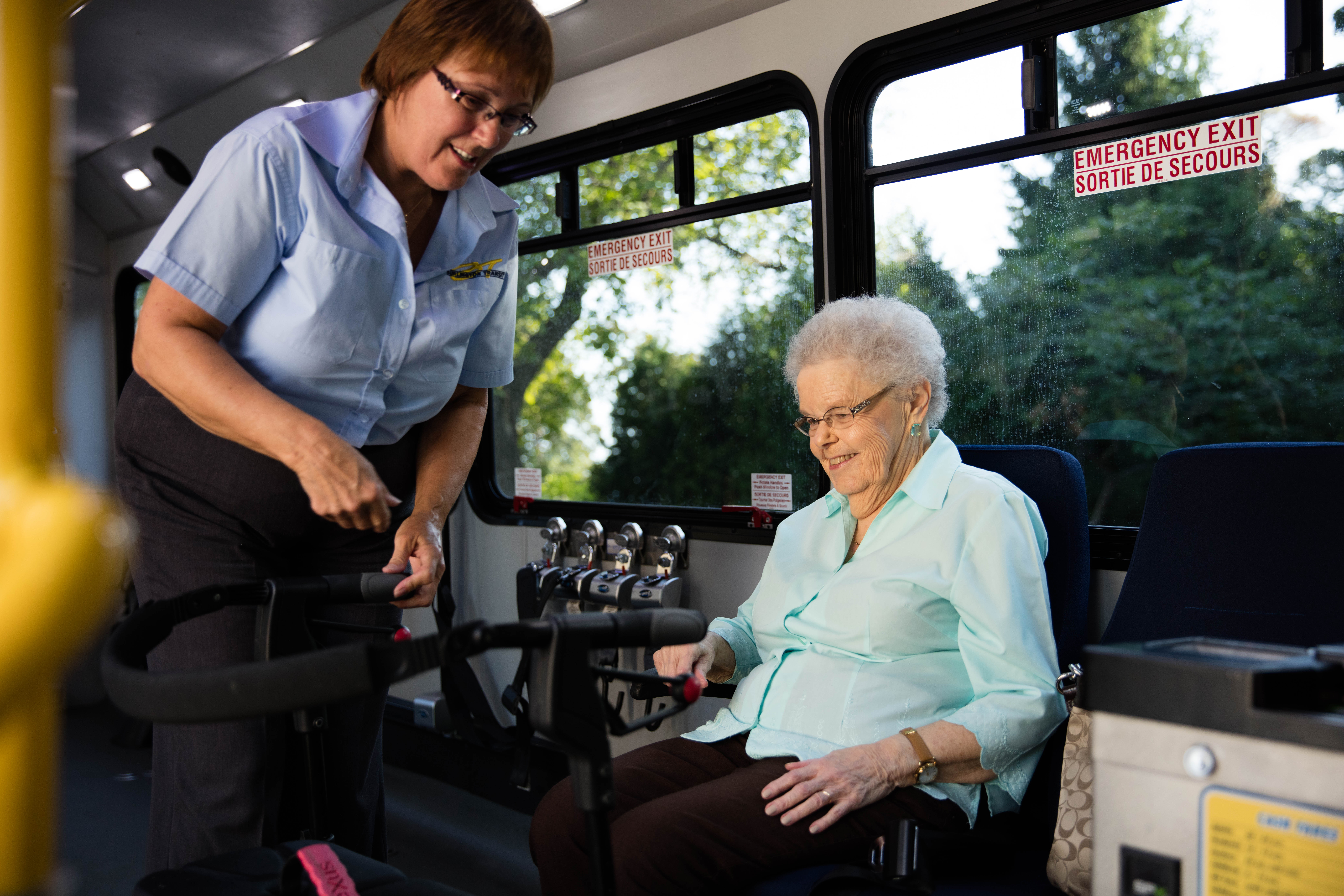Permanent, Integrated, and Locally Responsive: New Foundations for Public Transit Funding in Canada
Permanent, Integrated, and Locally Responsive: New Foundations for Public Transit Funding in Canada
Copyright
Aussi disponible en français sous le titre :
Permanent, intégré et adapté aux besoins locaux : De nouvelles bases pour le financement du transport en commun au Canada.
Information contained in this publication or product may be reproduced, in part or in whole, and by any means, for personal or public non-commercial purposes without charge or further permission, unless otherwise specified. Commercial reproduction and distribution are prohibited except with written permission from Infrastructure Canada.
For more information, contact:
Infrastructure Canada
180 Kent Street, Suite 1100
Ottawa, Ontario K1P 0B6
info@infc.gc.ca
© His Majesty the King in Right of Canada, as represented by the Minister of Intergovernmental Affairs, Infrastructure and Communities, 2022.
Cat. No. T94-48/2023E-PDF
ISBN 978-0-660-49073-1

New Permanent, Integrated, and Locally Responsive: New Foundations for Public Transit Funding in Canada (PDF Version)

Table of Contents
- Minister’s Foreword
- I. New Foundations for Public Transit Funding in Canada
- Our Engagement
- What We Heard – Key Stakeholder Messages
- Provide stable and predictable funding with flexible delivery
- Be responsive to local/regional priorities and realities
- Catalyze transit investments to address pressing social, environmental, and economic challenges
- Deliver improved governance and intergovernmental alignment
- Champion more transparent, evidence-based decision-making
- Our Response – Principles to Guide Design and Implementation
- II. What’s Next – From Ideas to Program Design
- APPENDIX A: Participant Information
Minister's Foreword
Following the Prime Minister's announcement of Canada's plan to permanently fund public transit, with an investment of $3 billion per year beginning in 2026-27, I looked forward to collaborating with our partners to design the future of public transit in Canada.
In July 2022, we launched an engagement paper detailing the Government of Canada's long-term vision for public transit and active transportation and requested feedback on the design of this new program. Since then, we received ideas and solutions from provinces, territories, municipalities, Indigenous peoples, transit agencies, policy experts, stakeholders, and Canadians that will help shape the future of public transit. This feedback builds on existing research studies, as well as the Government of Canada's research on transit, and will help ensure that permanent public transit funding delivers the greatest benefit to Canadians.
This Report outlines the key findings of our national engagement process and the principles that will help guide the design and implementation of permanent public transit funding as we work toward the program launch in 2026-27.
Permanent public transit funding is a transformative investment in the future of Canadian communities. It will help upgrade and expand public transit and active transportation networks to best meet local infrastructure needs across rural, urban, and Indigenous communities.
The Government of Canada continues to make historic investments in public transit, and combined with the permanent public transit fund, these investments will set up our communities for success in the decades to come.
With stable and predictable funding, we will work closely with provincial, territorial and municipal partners to ensure our investments in public transit also maximize key housing, social, environmental, and economic outcomes.
The thoughtful submissions received from Canadians will help ensure this long-term transit investment meets the needs of communities – large and small.
I look forward to working with our partners to bring this fund to life.
Thank you to all who participated.
The Honourable Dominic LeBlanc, P.C., K.C., M.P.
Minister of Intergovernmental Affairs, Infrastructure and Communities
I. New Foundations for Public Transit Funding in Canada
Our Engagement
From July 29 to October 14, 2022, the Government of Canada set out to gather ideas, feedback, and solutions from Canadians on how we can work together to make the most out of the first national permanent public transit fund.
Through the engagement paper and in discussions with partners, we set out a vision and key objectives for public transit that enhance mobility options for all Canadians and deliver other important benefits. To help achieve these objectives, we outlined several potential policy tools for feedback, including leveraging our investments to support the creation of complete communities, working collaboratively and effectively with transit partners to drive more integrated planning, considering sustainable financing solutions to address transit needs, and using data and evidence to inform decision-making.
We held 75 multi-stakeholder roundtables and bilateral meetings with our transit partners and received 71 written submissions and 391 questionnaire responses.
Canadians shared their excitement about public transit and active transportation and how they could impact local communities while helping to address some of our most important local, regional, national and global challenges.
Through these conversations with provinces, territories, municipalities, Indigenous communities, transit agencies, industry partners, independent experts, and transit and active transportation advocates, we gathered a pan-Canadian perspective that was united on the importance of stable and predictable public transit funding. Stakeholders also shared that collaboration between governments and transit agencies will help ensure that public transit funding delivers concrete and tangible results for communities.
Individuals from the public transit sector indicated that their organizations are still recovering from ridership and revenue losses due to the COVID-19 pandemic. The Government of Canada responded to those challenges in the immediate term with support for municipalities and transit agencies through the Safe Restart Agreement in 2020 and Budget 2022.
Our transit partners are responding with remarkable resiliency as transit ridership continues to recover to pre-pandemic levels. From a low of 16 percent, ridership has now reached 75.5 percent of pre-pandemic levels as of April 2023Footnote 1 – demonstrating how essential transit is to Canadians and to building sustainable, inclusive and prosperous communities.
As we work together to develop long-term, evidence-based and regionally integrated approaches to public transit across the country, the government will continue to fund transit projects through existing programs, including the Zero Emissions Transit Fund, the Active Transportation Fund, the Rural Transit Solutions Fund, the Investing in Canada Infrastructure Program, and the Canada Community-Building Fund. The government will also aim for a timely launch of permanent funding programs to ensure that partners are well positioned to access funds in 2026-27.
What We Heard – Key Stakeholder Messages
Through the engagement events and written submissions, five key themes emerged that will help set the foundation for the design of permanent public transit funding in Canada:
- Provide stable and predictable funding with flexible delivery
- Be responsive to local/regional priorities and realities
- Catalyze transit investments to address pressing social, environmental, and economic challenges
- Deliver improved governance and intergovernmental alignment
- Champion more transparent, evidence-based decision-making
The feedback received will guide the design and implementation of the fund.
1. Provide stable and predictable funding with flexible delivery
In Their Words
“A mix of solutions including stable, predictable and application-based, would benefit funding priority projects while still providing fair and equitable access to smaller recipients within provinces and territories.”
- Government of Ontario
 “This new program is a first step toward on-going, stable and sufficient funding to support increased transit service and modal share.”
“This new program is a first step toward on-going, stable and sufficient funding to support increased transit service and modal share.”
- Autorité régionale de transport métropolitain
“Many systems face the challenge of maintaining state of good repair for fleets, rail, and other supporting infrastructure. Funds should be allocated in a manner to ensure flexibility of use, as set out by transit systems, to ensure state of good repair for existing infrastructure or for capital expansion.”
- Canadian Urban Transit Association
 “The Fund should cover a full range of eligible capital costs, including early planning and design, rehabilitation and renewal of existing assets, system expansion, the shift to zero-emissions transit, and active transportation. Land acquisition should also be eligible to support transit-oriented development.”
“The Fund should cover a full range of eligible capital costs, including early planning and design, rehabilitation and renewal of existing assets, system expansion, the shift to zero-emissions transit, and active transportation. Land acquisition should also be eligible to support transit-oriented development.”
- Federation of Canadian Municipalities
In these engagement sessions, we heard that the foundation for successful public transit systems is reliable funding. Participants indicated that it is critical to establish consistent and transparent transit funding commitments from all governments and transit partners to address planning, budgetary, and other implementation challenges that have been magnified by supply-chain issues and global inflation. Stakeholders emphasized that predictable funding will go a long way to ensure that projects are delivered in a coordinated, timely manner with effectively estimated and managed costs.
While reliable capital funding to build new transit infrastructure was viewed as crucial, there was recognition that stable funding to maintain existing transit systems and meet life-cycle costs is also vital to maintain safe and reliable systems (e.g., state of good repair, rehabilitation, modernization).
Our partners emphasized the need to provide a mix of flexible funding solutions to ensure equitable access for communities and projects of all sizes. Many provinces, territories and municipalities identified a preference for broad and flexible transfer-based funding programs to support local infrastructure priorities and investments, such as the Canada Community-Building Fund.
It was also made clear that the sector continues to face challenges. The COVID-19 pandemic demonstrated how vital public transit is for Canadians. It also highlighted a need for more resilient, sustainable, and future-proofed transit systems that are not reliant on traditional sources of revenue alone to be responsive to long-term, changing conditions.
At the same time, we heard that the immense need for, and the associated costs of, major public transit projects cannot be met by governments on their own. There was interest in exploring the role of alternative financing and public-private partnerships to leverage all sources of funding to maximize project investments for communities, including longer-term dependable funding for city-regions, the diversification of revenue models, and potential financing options (e.g., Canada Infrastructure Bank (CIB) and private capital).
The CIB complements government funding programs by attracting private sector and institutional investments in revenue generating infrastructure projects in the public interest (e.g., zero-emission buses and the Réseau express métropolitain).
2. Be responsive to local/regional priorities and realities
In Their Words
“The Government of Canada has an important role to play as an informed partner-investor while respecting municipalities are the experts in conceiving and delivering local transit capital projects within their communities.”
- City of Calgary
 “Government must recognize that there cannot be a one-size-fits-all approach to the permanent funding for public transit. Government must be adapted to the needs of local communities.”
“Government must recognize that there cannot be a one-size-fits-all approach to the permanent funding for public transit. Government must be adapted to the needs of local communities.”
- Canadian Chamber of Commerce
“Each municipality is unique, rural municipalities will differ from their urban counterparts. Special consideration needs to be made for rural municipalities regarding funding amounts and the scale or scope of the project.”
- Saskatchewan Association of Rural Municipalities
“One size does not fit all. Public transit is essential for large urban areas, small urban areas (like Fredericton or Moncton), and in rural areas; however, the challenges and needs to serve these areas are different.”
- Government of New Brunswick
While participants expressed a need and desire to work better together, provinces, territories, municipalities, transit agencies, and Indigenous communities – owners and operators of infrastructure – told us that they are best suited to identify their local needs, priorities, and solutions, and require funding that is responsive to this.
We heard that capital needs, housing affordability challenges, and growth pressures are most acute in major metropolitan centres, and that these needs may not be adequately supported through existing governance and funding arrangements.
In addition, smaller, rural, remote, and Indigenous communities highlighted the need for accessible and inclusive transit options to get people to nearby communities for work, school, appointments and family visits. They also stressed the importance of tailored programs designed to address their unique realities, including limited complexity and administrative burden, especially in the delivery of small, routine projects.
3. Catalyze transit investments to address pressing social, environmental, and economic challenges
In Their Words
“Transit projects should be viewed as investments, not expenditures ... transit generates new property tax revenues, revitalizes neighborhoods, creates new jobs and facilitates access for workers through reduced congestion and lower travel costs for both the user and employer compared to car travel.”
- Alliance TRANSIT
 “Public transit plays a pivotal role in the health and prosperity of communities across Canada. As our country continues to recover from the COVID-19 pandemic, transit and other forms of sustainable transportation are helping to address some of the biggest challenges of our time: climate change, housing affordability, immigrant settlement, social equity, reconciliation, economic competitiveness, and productivity.”
“Public transit plays a pivotal role in the health and prosperity of communities across Canada. As our country continues to recover from the COVID-19 pandemic, transit and other forms of sustainable transportation are helping to address some of the biggest challenges of our time: climate change, housing affordability, immigrant settlement, social equity, reconciliation, economic competitiveness, and productivity.”
- TransLink Mayors' Council on Regional Transportation
“These investments demonstrate the federal government's recognition of public transit's importance, not only in the fight against climate change, but also for the vitality of large cities, the development of affordable housing and the growth of a robust, sustainable and inclusive economy across the country.”
- Société de transport de Montréal
“The permanent public transit fund is a historic opportunity to decarbonize the transport sector, while delivering a more inclusive economy and fostering greater social equity.”
- Environmental Defence Canada
 “The growing need for net zero transport points to the need to seriously invest in new technologies that run on clean energy.”
“The growing need for net zero transport points to the need to seriously invest in new technologies that run on clean energy.”
- Canadian Urban Transit Research & Innovation Consortium
“Support and fund transit plans that aim to strengthen agglomeration economies by improving travel time reliability, connecting workers with jobs, goods with markets, and people with places.”
- Government of British Columbia
“Public transit is important to the future of the planet and achieving our shared goals for land use, housing, inclusion, carbon neutrality and economic development. Sustained efforts are needed and should involve all stakeholders, from planning to maintenance.”
- Ville de Montréal
 “The Government of Canada has the opportunity to be a recognized leader in breaking down barriers for people with disabilities by ensuring that built environment accessibility is of utmost importance in its plans for permanent public transit infrastructure.”
“The Government of Canada has the opportunity to be a recognized leader in breaking down barriers for people with disabilities by ensuring that built environment accessibility is of utmost importance in its plans for permanent public transit infrastructure.”
- Rick Hansen Foundation
“Accessible public transit fosters inclusive communities where everyone can fully participate. Because people with sight loss can't operate their own vehicle, they rely heavily on accessible, efficient, and reliable public transit. Without it, people who are blind or partially sighted may experience reduced independence, higher rates of unemployment, limited recreational opportunities, and increased social isolation.”
- CNIB Foundation
Across the country, we heard that there is a pressing need for transit investments to help address congestion, housing affordability, social inclusion, and climate change in addition to advancing key transit goals, such as increasing the modal share of transit ridership. Participants indicated that more work is required to leverage investments between all governments to deliver results and co-benefits.
Our stakeholders emphasized the following:
Catalyze complete communities: Effective public transit and active transportation provide clean and more affordable access to jobs, services, and recreation. Leveraging these investments is an effective way to build more sustainable, inclusive, and complete communities. Active transportation infrastructure is a foundational part of a connected, multimodal transport system in communities. Adequate, flexible and stable funding is also key to supporting active transportation initiatives on the ground.
Target density and mixed land use: Current investment and growth patterns do not result in sufficient population, job and service density near existing and new transit and transportation-rich areas, with too much low-density greenfield development. This is exacerbated by inconsistent integration of transit, active transportation, and land-use planning. Not only does this lead to long commute times, congestion, and lack of affordable housing options, it also has significant impacts on our efforts to reduce greenhouse gas emissions.
Support adequate housing supply: Affordable housing shortages of all types magnify equity impacts, particularly in large urban areas. The supply gap has exacerbated home rental price increases, with prices growing faster than incomes in many communities. The creation of dense, transit-oriented, complete communities could improve housing supply and affordability and address population growth pressures, while supporting Canada's immigration and refugee goals.
Address accessibility and equity: Equity-deserving groups, including women, racialized people, Indigenous peoples, persons with disabilities, newcomers, seniors, low-income individuals, and people experiencing homelessness, tend to rely more on public transit. Lack of attention to the equity impacts of transit policies, data collection, and investments can result in marginalization of equity-deserving groups and exacerbate structural barriers to their full participation in society.
Project development and construction may disrupt communities, including gentrification or displacement through land value increases. Transit operations are not always user-centred, which creates outsized impacts on those requiring barrier-free environments and can impact anyone travelling across jurisdictional boundaries that produce artificial barriers to regional mobility.
4. Deliver improved governance and intergovernmental alignment
In Their Words
 “We need to plan and build for growth, instead of just responding to growth. The Board recommends that the federal funding tied to creation of a comprehensive regional transportation plan, including fully integrated fares and service. Our urban regions are integrated economic units, and their transit systems need to be equally integrated.”
“We need to plan and build for growth, instead of just responding to growth. The Board recommends that the federal funding tied to creation of a comprehensive regional transportation plan, including fully integrated fares and service. Our urban regions are integrated economic units, and their transit systems need to be equally integrated.”
- Toronto Region Board of Trade
“[T]he Permanent Public Transit Fund [should] be designed in such a way that major capital projects (i.e. mass transit expansion) are identified and prioritized through integrated transportation and land use master plans.”
- City of Edmonton
“The new fund can also enable direct federal involvement in existing provincial-municipal governance structures where appropriate, enabling tri-government collaboration on transit.”
- City of Toronto
“Optimal coordination among partners will help achieve desired outcomes. This requires streamlining and coordinating approval and reporting processes, while ensuring that project requirements from all orders of government are aligned.”
- Autorité régionale de transport métropolitain
“Preliminary conversations among all levels of government about broad plans and priorities prior to the application phase can be extremely useful to ensure that funding applications are properly targeted and streamlined – i.e., eases the application and agreement process.”
- Halifax Regional Municipality
Throughout our engagement, we heard transit projects entail a complex ecosystem of needs, interests, governance, and decision-making that should be strengthened, including through the creation or improvement of formal structures to ensure collaborative planning and investments that maximize outcomes for residents.
We also heard that funding partners need to improve alignment on program criteria, budgeting and project prioritization in a way that reflects local needs.
Stakeholders highlighted that a lack of coordination within regions hinders the effectiveness of public transit investments and continues to lead to unrealized benefits. For example, transit planning may not sufficiently consider housing density or amenities (jobs, services, recreational facilities, water infrastructure), while zoning and development requirements can vary across jurisdictions, causing differentiated regional housing affordability and mobility access outcomes.
Finally, we heard that we could improve coordination within the federal government to enable partners to harness other federal programming (e.g., Canada Mortgage and Housing Corporation, Canada Infrastructure Bank) or federally owned lands (e.g., Public Services and Procurement Canada, Canada Lands Company).
5. Champion more transparent, evidence-based decision-making
In Their Words

“Capital funding decisions should be evidence-based, transparent and coordinated with other programs.”
- Transportation Association of Canada
“It is critical that the Government of Canada signals the importance of long-term performance in the structure of the funding model.”
- ARUP Group
 “Continued standardization of life-cycle data and information collected from transit agencies could streamline the analysis process and help to determine gaps and opportunities for efficiencies (including collaboration across jurisdictions). This could be achieved through ongoing collaboration with organizations such as CUTA (Canadian Urban Transit Association) to determine approaches to standardizing data collected from agencies.”
“Continued standardization of life-cycle data and information collected from transit agencies could streamline the analysis process and help to determine gaps and opportunities for efficiencies (including collaboration across jurisdictions). This could be achieved through ongoing collaboration with organizations such as CUTA (Canadian Urban Transit Association) to determine approaches to standardizing data collected from agencies.”
- Government of Ontario
Partners shared the need for national, standardized data and indicators to support decision-making and project prioritization across the country.
Many respondents highlighted the benefits of using enhanced evidence-based decision-making to allow for the transparent evaluation of proposed public transit projects and operational results.
Smaller communities noted challenges in accessing data and supports for identifying, prioritizing, and planning transit projects. They also highlighted the need for data gathering, monitoring and reporting support due to capacity constraints.
Our Response – Principles to Guide Design and Implementation
The feedback and ideas shared have helped to refine and shape guiding principles of the design and implementation of the permanent public transit fund. These principles will underpin our goal to support safe, modern, and efficient public transit systems, build complete and inclusive communities, and improve outcomes for Canadians.
Provide stable and predictable capital and planning funding in concert with investments by provincial, territorial, and municipal partners to enhance our collective ability to plan, maintain and deliver more accessible, resilient and sustainable transit systems. Permanent public transit funding will provide stable support for the capital investment needs of Canada's public transit systems, while relying on our provincial and municipal partners, who control operational decisions, to identify and meet the needs of their communities.

Support flexible delivery with a mix of funding mechanisms, including streamlined administrative approaches to better align program requirements with desired outcomes, and mutually reinforcing funding mechanisms to ensure that investments create positive short-term and long-term outcomes.
We will provide funding options to meet the unique needs of communities of all sizes and geographical realities, including larger cities as well as mid-sized, rural, remote, and Indigenous communities, including by:
- Providing communities of all sizes with access to a base of predictable funding for smaller and routine needs like state of good repair, rehabilitation, and minor expansions, with additional opportunities to apply and obtain funding for existing and emerging priorities (e.g., rural transit solutions, zero-emissions transit, and active transportation).
- Supporting long-term integrated regional plans in metropolitan regions with funding agreements that link to transit co-benefits such as housing and GHG reductions to go beyond a project-by-project approach and maximize the impact of other land-use policies or investments in transit and related outcomes.
These approaches will be complemented by the Canada Community-Building Fund, approximately a third of which is used for public transit. This additional source of permanent funding provided to municipalities through provinces and territories is up for renewal in 2023/2024.

Advance place-based approaches that respect the specific needs and priorities of our partners and provide opportunity for local and regional leadership while ensuring results for Canadians, including:
- Empowering local and regional leaders in metropolitan regions to identify the needs of their communities and harness innovative best-in-class approaches, while linking to effective outcomes and targets that produce results and provide accountability for investment decisions.
- Providing access to flexible program delivery, and enhanced outreach and planning supports to meet the needs of smaller, remote, rural, and Indigenous communities and reduce the administrative burden for all our partners. This could include transit solutions that support riders’ day-to-day activities and connections with nearby communities that offer vital services, from employment and education to healthcare.
Drive social, environmental, and economic outcomes by working with other levels of government and transit partners to leverage transit investments to reduce emissions and support complete communities. We will look to maximize the transit user experience, expand access to employment opportunities and housing, mitigate climate change, and improve equity and inclusion. This includes:
- Exploring policy options with our partners to encourage equity-focused planning, data collection, and building affordable housing and active transportation near transit and other amenities. We will consider ideas such as community benefit agreements, employment benefit frameworks, and local procurement opportunities.
- Examining how our investments can meaningfully reduce GHG emissions to help deliver on Canada’s 2030 Emissions Reduction Plan and reach net-zero by 2050 and support the government’s National Adaptation Strategy, which sets a vision and goals to increase Canada’s resiliency to the impacts of climate change.
- Considering ways to support made-in-Canada low-carbon construction materials and reciprocal procurement measures.
Improve governance and intergovernmental alignment by encouraging more long-term and coordinated decision-making among governments and other transit partners – especially in larger metropolitan regions. This includes the potential to support enhanced regional governance structures and integrated regional planning to improve the coordination of regional transit and other interrelated investments such as housing, resulting in better outcomes for all residents. The government will achieve these objectives by:
- Taking a long-term integrated approach that looks to leverage relationships and review processes among relevant federal departments and agencies to support our public transit partners more directly, particularly for housing and community amenity developments near transit.
- Seeking opportunities to coordinate investments from federal departments and agencies with relevant programming or real estate holdings.
Enhance evidence-based decision-making for funding programs in close collaboration with our partners, including through common indicators and metrics for similar projects, standardized methods for collecting data, and applying consistent approaches to determine whether project targets or outcomes are met. This includes:
- Working with our partners to explore how to expand the use of technical experts to support transparent decision-making processes, including through data and research, planning, as well as the identification of needs and establishment of targets for communities.
- Building upon our existing commitments to support additional evidence-based decision-making capacity for communities across the country.
- Creating an advisory body of experts from across the sector to undertake Canada’s first National Infrastructure Assessment (NIA), which will serve as a foundational tool to identify Canada's infrastructure needs and priorities, and will undertake evidence-based long-term planning into 2050.
- Supporting the next phase of infrastructure funding and decision-making. The NIA will provide governments with impartial, expert research and analysis – grounded in evidence and developed openly and transparently – to better inform infrastructure investments.
II. What’s Next – From Ideas to Program Design
Permanent public transit funding offers an opportunity for all governments and transit partners to work together to enhance integrated planning and evidence-based decision-making and catalyze long-term investments in public transit that are responsive to local and regional needs.
The broad participation of partners and stakeholders in this public engagement process is encouraging and we want to thank everyone who contributed.
Over the next months, the government will work closely with our transit partners on the path forward, and Infrastructure Canada staff will play a crucial role in supporting enhanced engagement and integrated, place-based approaches that are attuned to the unique realities of Canada’s diverse communities. This work will be critical to ensuring that the government can reach its goal of launching key elements of the permanent transit funding program in the near future in order to flow funding in 2026/2027.
We look forward to continued discussions with our partners to ensure that we get the details right and strengthen our collective ability to deliver high-quality and accessible public transit and active transportation and improve the quality of life for Canadians.

APPENDIX A: Participant Information
Organizations that provided submissions
National
- Amalgamated Transit Union (ATU) Canada
- Canadian Chamber of Commerce
- Canadian Home Builders’ Association
- David Suzuki Foundation
- Environmental Defence Canada
- Railway Association of Canada
- Transport Action Canada
- Clean Energy Canada
- Canadian Automobile Association
- CNIB Foundation
- Canadian Urban Transit Association (CUTA)
- Canadian Union of Public Employees (CUPE)
- Canadian Urban Transit Research and Innovation Consortium (CUTRIC)
- Green Communities Canada
- Trans Canada Trail
- Active School Travel Canada
- Heart and Stroke Foundation
- ARUP Group
- Active Transportation Alliance of Canada
- Via Transportation
- National Farmers Union
- Federation of Canadian Municipalities
- Alstom
- UNIFOR
British Columbia
- Government of British Columbia
- Amalgamated Transit Union (ATU) Local 1724
- BC Transit
- BC Urban Mayors’ Caucus
- Greater Vancouver Board of Trade
- HUB Cycling
- Metro Vancouver
- TransLink Mayors’ Council on Regional Transportation
- City of Surrey
- City of Vancouver
Alberta
- City of Edmonton
- Edmonton Metropolitan Transit Services Commission
- City of Calgary
- Government of Alberta
Saskatchewan
- Saskatchewan Association of Rural Municipalities
Ontario
- Government of Ontario
- City of Brampton
- Township of Conmee
- Community Benefits Ontario
- Durham Region Transit
- Eastern Ontario Wardens’ Caucus
- Hamilton Transit Riders Union
- Town of Oakville
- Ontario Federation of Indigenous Friendship Centres
- City of Ottawa
- Region of Peel
- Residential and Civil Construction Alliance of Ontario
- City of Toronto
- Toronto Region Board of Trade
- Toronto Transit Commission
- Region of Waterloo
- York Region
Québec
- Accès transports viables
- Alliance TRANSIT (with participation of eight Quebec organizations)
- Association pour la santé publique du Québec
- Association du transport urbain du Québec (with participation of 10 Québec transit agencies)
- Autorité régionale de transport métropolitain
- Quebec Business Council on the Environment
- Gouvernement du Québec
- Ville de Longueuil
- Ville de Montréal
- Société de transport de Montréal
- Trajectoire Québec
New Brunswick
- City of Fredericton
- Fredericton Chamber of Commerce
- Government of New Brunswick
Nova Scotia
- Halifax Regional Municipality
- Nova Scotia Federation of Municipalities
- Ministry of Public Works
Prince Edward Island
- Construction Association of Prince Edward Island
- Government of Prince Edward Island
Organizations that provided questionnaire responses
National
- ARUP Group
- Canadian Urban Transit Research & Innovation Consortium
- Canadian Women’s Foundation
- Federation of Canadian Municipalities
- National Capital Commission
- Rick Hansen Foundation
- WSP in Canada
British Columbia
- BC Transit
- Government of British Columbia
- Capital Regional District
- City of Fernie
- Galiano Island
- Regional District of Kitimat-Stikine
- City of Mission
- City of Port Coquitlam
- City of Powell River
- City of Prince Rupert
- Provincial Working Group on Seniors’ Transportation
- Rail for the Valley
- Red Resort Association
- District of Sechelt
- TransLink
Alberta
- City of Airdrie
- Bow Valley Regional Transit Services Commission
- City of Calgary
- Calgary Metropolitan Region Board
- Edmonton Metropolitan Transit Services Commission
- Town of Hinton
- City of Lloydminster
- County of Newell
- County of Stettler
- Strathcona County
- Municipal District of Wainwright No. 61
Saskatchewan
- Rural Municipality of Arborfield No. 456
- Bus Riders of Saskatoon
- City of Moose Jaw
- City of Saskatoon
- City of Yorkton
- City of Swift Current
Manitoba
- Rural Municipality of Gimli
- Handi Van Transit
- Government of Manitoba
- City of Morden
- City of Portage la Prairie
- Rural Municipality of West Interlake
- City of Winnipeg
Ontario
- City of Brampton
- City of Brantford
- Burlington for Accessible Sustainable Transit
- Citizens for Alternative Transportation in Trent Lakes
- CodeRedTO
- Community Benefits Ontario
- City of Hamilton
- City of Kawartha Lakes
- Kingston, Frontenac and Lennox & Addington Public Health
- City of Mississauga
- Government of Ontario
- City of Ottawa
- Oxford County
- VIA Rail through Thunder Bay and North Shore of Lake Superior
Québec
- Associations des Centres de gestion des déplacements
- Association d’usagers du transport collectif de Longueuil
- Chamber of Commerce of Metropolitan Montreal
- Quebec Business Council on the Environment
- Ville de Laval
- Ville de Sherbrooke
- Table des préfets et élus de la couronne Nord
- Ville de Terrebonne
- Vivre en Ville
New Brunswick
- City of Fredericton
- City of Moncton
- Government of New Brunswick
Nova Scotia
- Coopérative de transport L’Acabie
- Municipality of the County of Inverness
- Shelburne County rural transit organization
Prince Edward Island
- Rural Municipality of Eastern Kings
- Government of Prince Edward Island
Yukon
- City of Whitehorse
List of meetings
National
- Big City Intergovernmental Table
- Canada Infrastructure Bank
- Canadian Urban Transit Association
- Canadian Urban Transit Research & Innovation Consortium
- Federation of Canadian Municipalities
British Columbia
- Government of British Columbia
- BC Transit
- Metro Vancouver
- TransLink
- City of Surrey
- Union of BC Municipalities
- City of Vancouver
Alberta
- Alberta Municipalities
- City of Edmonton
- Edmonton Metropolitan Transit Services Commission
- Government of Alberta
Saskatchewan
- City of Regina
- Government of Saskatchewan
Manitoba
- Association of Manitoba Municipalities
- Government of Manitoba
- City of Winnipeg
Ontario
- Association of Municipalities of Ontario
- Durham Region Transit
- City of Guelph
- City of Hamilton
- Niagara Region
- City of Ottawa
- Region of Peel
- City of Toronto
- Toronto Community Housing
- Toronto Region Board of Trade
- Toronto Transit Commission
- York Region
Québec
- Autorité régionale de transport métropolitain
- Association des transports collectifs ruraux du Québec
- Association du transport urbain du Québec (with the participation of 10 Québec transit agencies)
- Communauté métropolitaine de Québec
- Gouvernement du Québec
- Ville de Montréal
- Union des municipalités du Québec
- Ville de Québec
New Brunswick
- Government of New Brunswick
Nova Scotia
- Halifax Joint Regional Transportation Agency
- Halifax Regional Municipality
Newfoundland and Labrador
- Government of Newfoundland and Labrador
Prince Edward Island
- Government of Prince Edward Island
Indigenous Communities and Organizations
- Assembly of First Nations
- Congress of Aboriginal Peoples
- Inuit Tapiriit Kanatami
- Manitoba Métis Federation
- Métis National Council
List of Roundtables
Infrastructure Canada conducted a series of ten regional roundtables on the future permanent public transit fund, and an eleventh session focused on active transportation. These sessions brought together transit users, representatives of transit agencies, academia, community organizations, and local government to discuss how to leverage the fund to build more inclusive, complete communities across the country, including:
- Canadian Urban Transit Association - August 17
- Ontario (focus on southern Ontario) - September 7
- British Columbia - September 7
- Québec (focus on the Montréal area) - September 8
- Saskatchewan - September 8
- Ontario (focus on Northern Ontario) – September 14
- Alberta - September 14
- Québec - September 15
- Manitoba - September 15
- Atlantic Canada - September 22
- Northern Canada - September 22
- Active Transportation National Roundtable – September 29
- Canadian Urban Transit Research & Innovation Consortium National Roundtable on Zero Emissions Transit – November 2
Report a problem on this page
- Date modified: